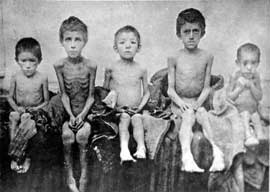
November 11, 2013

Last week saw commemorations of the 75th anniversary of Germany’s Kristallnacht and the 80th anniversary of the Ukrainian Holodomor. Judging from Western news coverage, Kristallnacht wins by a landslide.
On Google News, results for the words “Kristallnacht” and “Holocaust” outnumbered mentions of “Holodomor” at a clip of nearly 80-1. On a general Google search, “Holocaust” outpaces “Holodomor” by a less feverish, yet still insane, pace of 40-1.
Estimates for the death tolls of the Holocaust and Holodomor range all over the place”usually correlated (surprise!) with how much ethnic and political sympathy the estimator has for the deceased”but a rough consensus is that the number of victims was roughly the same.
Yet one would have to be smoking banana peels dipped in formaldehyde and sprinkled with PCP to assert that both events receive a similar amount of attention in Western media and academia.
Wait”aren”t all dead bodies created equal? Why the galloping disparity in public awareness of these dueling atrocities?
Some would say it’s because Western academia is dominated by leftists who are loath to acknowledge their chosen creed’s historical capacity for totalitarian cruelty.
Others would say it’s because Western media is dominated by people who are more sympathetic to Jewish people than to Christians.
Yet others would assert it’s because the USA fought alongside the Soviet Union in WWII and thus wants to avoid appearing complicit in the deliberate starvation of millions.
I’ll pick “all of the above.”
It is generally agreed that Joseph Stalin viewed Ukrainian nationalism as an impediment to global communist ascendancy. Piece by piece, the Soviets attempted to smash Ukrainian identity into the dirt. There was a purge of poets and intellectuals. Then came the decimation of the Ukrainian Orthodox Church. Then came the demonization and divestiture of middle-class farmers, AKA “kulaks.” And then pretty much every lowly farmer in the Ukraine, breadbasket of Eastern Europe, was rendered an unpaid serf during forcible agricultural collectivization. In a manner that can only be deemed punitive, Soviet forces seized Ukrainian harvests and exported them to be consumed in Russia and sold on Western markets. The Ukraine was effectively cordoned off and international charity organizations were turned away at the border, leaving Ukrainians trapped in barren fields of death while the world feasted on their labor.
At the height of the Ukrainian famine of 1932-33, an estimated 25,000-30,000 peasants, at least 80% of them ethnic Ukrainians, were starving to death daily. The images and film footage is creepily reminiscent of the bony unfortunates rotting away in subsequent German concentration camps during the Holocaust. Decades later this Soviet act of forcible starvation was dubbed the “Holodomor,” which roughly translates as “murder by hunger.”
By the spring of 1933 I saw neither dogs nor cats in our village, they were all eaten by our people that winter, but not just their pets but their children, even the dead were dug up from the cemeteries and eaten. (oral testimony of Michel Korhun)
In January of 1933, Yar learned, the mother had lost her mind, looked out into the farmyard and seen a huge turkey. She rushed out, slew it with a knife, and put it in a cooking pot. After eating her fill of the resulting stew, she looked for her daughter to share what was left. But all she could find was her daughter’s cap, all bloody. Returning to her senses, she realized she had killed her daughter. (oral testimony of Yar Slavutych)
A medical team does a sort of selection process…anyone who is not yet swollen up and still has a chance of survival is directed to…buildings, where a constant population of about 8,000 lies dying on straw beds….Most of them are children. People who are already starting to swell up are moved out in good trains and abandoned about forty miles out of town so that they can die out of sight. (report from the Italian Consul in Kharkiv)